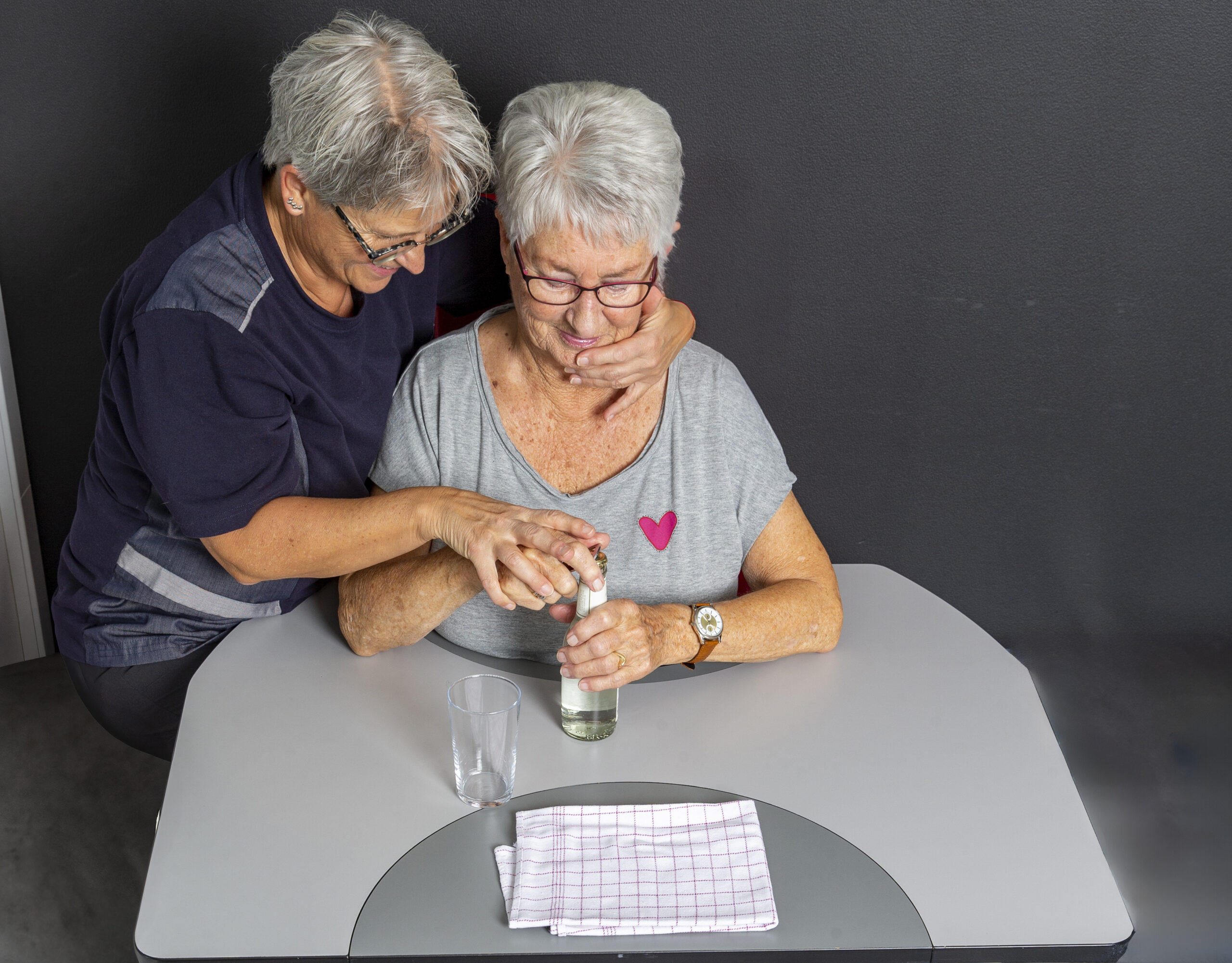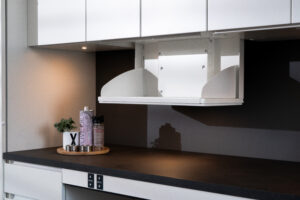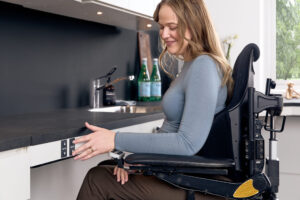The ErgoMulti table is recommended by experts
Apr 20, 2020
•Table solutions
Experts recommend the ErgoMulti table for rehabilitation and therapy, highlighting its ergonomic design and support for users and therapists during training.
Table of Contents
It’s no secret that the ErgoMulti table is designed because we wanted to create the optimum training table. We believe we have succeeded. Fortunately, we are not the only ones who share that opinion.
Annette Kjærsgaard is an occupational therapy specialist with a PhD in dysphagia. Dysphagia is a swallowing disorder and a symptom that may occur in connection with neurological diseases like Parkinson’s disease, sclerosis and brain injuries. In her latest book about dysphagia, Anette has made a series of professional descriptions, where she uses the ErgoMulti table for the rehabilitation of people with dysphagia.
Professional descriptions of the ErgoMulti training table
By Annette Kjærsgaard, occupational therapyspecialist with a PhD in dysphagia, owner of Dysfagiklinikken (Dysphagia Clinic)
Stable exit position and appropriate working position
The ErgoMulti table can support a stable exit position for the user and at the same time support a suitable working position for the occupational therapist when conducting face, mouth and throat therapy. The table design with two carvings and rounded edges makes it possible for the occupational therapist to get close to the user without having to sit or stand in inappropriate working postures.
Forearm and elbow support
The design of the ErgoMulti table with carvings, brake wheels and the possibility for manual height adjustment makes it possible for the user to sit well supported with the feet on the floor, the stomach towards the table edge and the forearms/elbows on the table regardless of whether the user sits on an ordinary chair, an active or comfort wheelchair or a treatment bench.
The boomerang system with two different sizes of carvings on the user’s side of the table,
gives the user suitable support of the forearms/elbows no matter if the person is a child/adult or if the person has a slight/sturdy build. The crescent-shaped leaf which can be mounted on the therapist’s side of the table makes the table useful for training of several activities, e.g. a meal where there has to be room for a glass, a plate and cutlery, or for the examination of the mouth where there has to be room for a glass with water, napkin, examination light, etc.
Optimum training table for examination and treatment of face, mouth and throat
The ErgoMulti table can be adjusted individually for children and adults and can be used for several persons and activities. Such a table is ideal for hospitals and institutions where examination and treatment of people with functional impairments of the face, mouth and throat are conducted as it supports an optimum sitting and head position for the patient/user and makes it possible for the occupational therapist to obtain a good working position. Furthermore, the table is easy to clean, user-friendly and of a quality that makes it an investment that lasts for years.
Examples from clinical practice using the ErgoMulti table
In the below, four professional scenarios are described where the ErgoMulti table is used in clinical practice when examining the face, mouth and throat.
1. The patient sits on a bench at the ErgoMulti table with one carving, and the occupational therapist sits next to the person on the bench
The patient is examined with therapeutic eating focusing on the pre-oral phase, where she is guided to open a bottle. The patient sits on a bench with the feet on the ground, the stomach towards the table edge and both forearms/elbows supported on the table. As she cannot hold her head, there is a need for the occupational therapist to assist her with a jaw hold from the side.
The occupational therapist sits on a pack next to the patient on the bench. Hence, she becomes slightly elevated and can hold the jaw from the side without straining her shoulders unnecessarily. The occupational therapist also has her left leg behind the back of the patient to support an upright sitting position with the stomach towards the table edge, so the patient gets an ideal sitting and head posture to drink which is the aim of this exercise.
The right leg of the occupational therapist is along the patient’s right leg as stability, and it will also be possible for the occupational therapist to feel and adjust the patient’s sitting position if the patient’s pelvis slides forwards during the examination.
The rounded edges of the table make it possible for the occupational therapist to get close to the patient and thereby support the person better to get a stable and symmetrical sitting and head posture. The table’s brakes must be turned on on all four wheels to ensure that it stands firmly during the examination. It is also a prerequisite in the following three professional descriptions.
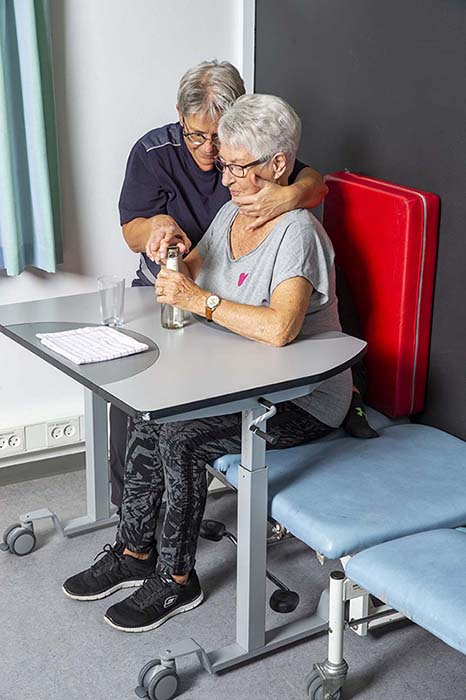
2. The patient sits on a bench at the ErgoMulti table with two carvings, and the occupational therapist sits in front with one knee on a pack
The occupational therapist conducts a visual examination of the mouth where she is focusing on inspection of lips, teeth, gums, tongue, cheeks and soft palate during rest. In this incident, the patient can hold the head herself. Therefore, an exit position where the occupational therapist sits in front to get a good view of the patient’s mouth during the examination is chosen.
The patient sits on a treatment bench with the feet on the ground, the stomach towards the table edge and the forearms/elbows supported, and the weight on the arms on the table. She has a pack in the back and a pillow behind the lumbar area to support an upright sitting position at the table.
When the ErgoMulti table is used like this with two carvings, the occupational therapist can sit closely, in front of the patient and below eyesight which is important to get a good starting point for swallowing. If the patient looks up at the occupational therapist, it will shorten the patient’s neck and make swallowing difficult. The occupational therapist supports the head and lower jaw by holding the jaw from the front. If required, the occupational therapist may stabilise the left elbow on the table, e.g. supported by a coiled-up towel. The fact that the occupational therapist can get close to the patient and obtain elbow support can reduce the static work which a jaw hold from the front may entail if the examination lasts several minutes.
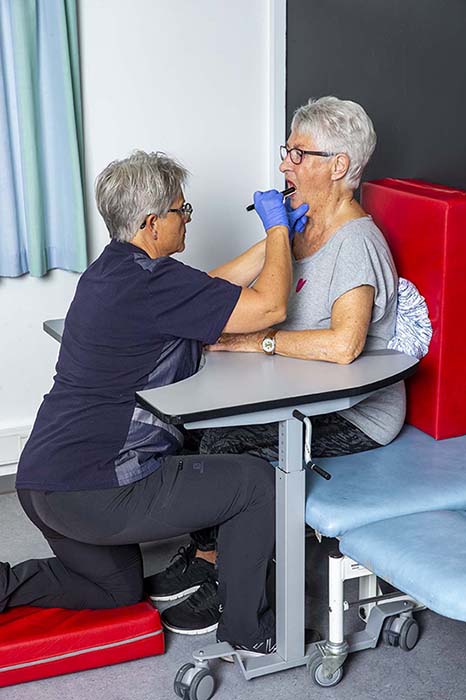
3. The patient sits in a comfort wheelchair by the ErgoMulti table with one carving, and the occupational therapist stands next to the person
Therapeutic eating is here conducted as an examination where the patient is guided in the pre-oral phase to move the spoon to the mouth. The focus is on the eye-hand and hand-mouth coordination. The ErgoMulti table’s carving makes it possible to support the patient’s forearms/elbows in connection with the eating activity. The patient gets appropriate table support to hold the bowl, and it makes it easier for her to move the right arm/hand with the spoon to the mouth.
The patient sits in a comfort wheelchair because she has limited body stability and cannot sit without support. Foot and arm supports are de-mounted, and the chair is tilted forwards with both seat and back, so the patient gets weight on the forearms/elbows through the table and weight on the feet through a pack since the wheelchair is too high for her to reach the floor with the feet.
As the patient cannot hold the head, the occupational therapist uses a jaw hold, where she stands on the right side of the patient to support her body, head and jaw position. The rounded edges of the ErgoMulti table make it possible for the occupational therapist to get close to the patient, and thereby she can support the patient’s exit position better and at the same time get an appropriate working posture herself.
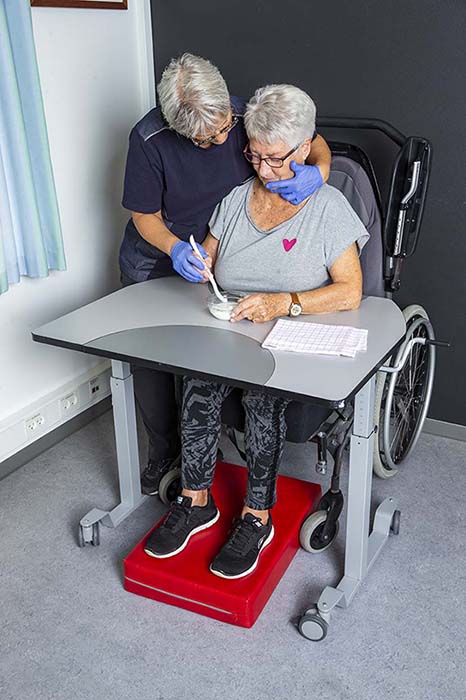
4. The patient sits in an active wheelchair at the ErgoMulti table with two carvings, and the occupational therapist sits in front with one knee on a pack
The patient is examined with a tactile examination of the mouth where sense of feeling and mouth movement, as well as saliva swallowing, is assessed. The patient sits in an active wheelchair with the foot supports de-mounted and with a pack under the feet as she otherwise would not be able to reach the floor. The arm supports are also de-mounted, and she has a pillow in the back to get an upright sitting position with the stomach towards the table edge and the weight on the forearms/elbows, which lie well supported on the table with the forearms/elbows on the table. In this example, the patient could also be sitting on an ordinary dining chair without arm supports with a pillow or wedge in the back and the feet on the floor.
The ErgoMulti table’s two carvings make it possible for the occupational therapist to get below eyesight, close to the patient, reach good eye contact from the front and at the same time get a stable working position to support the patient with a jaw hold from the front. Here, the occupational therapist supports the left elbow on the table, which helps minimise the static work for hand, arm and shoulder.
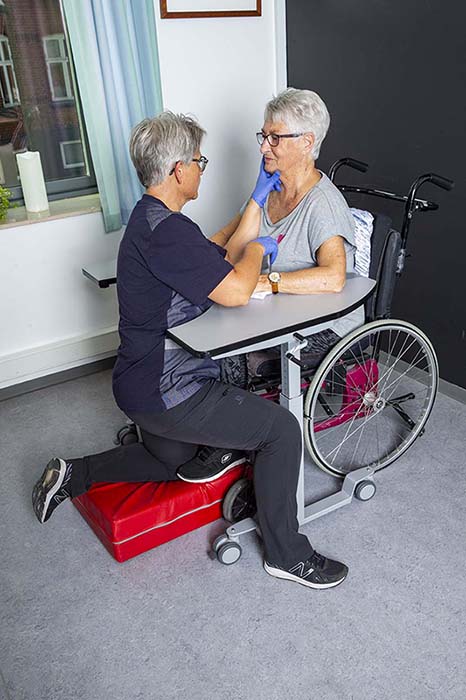
The ErgoMulti table makes rehabilitation better for both users and therapists
In the descriptions, Anette uses the ErgoMulti table in specific rehabilitation situations with a patient. It is a professional evaluation of how the table works using occupational therapeutic methods. Anette’s professional assessment confirms that the ErgoMulti table is ideal for rehabilitation, and it demonstrates how the tables well thought out design makes it possible to help and support the patient in the best possible way.
With the right aids in training, therapy and rehabilitation, the patients will experience faster progress in the rehabilitation, and the occupational therapist gets the optimum working positions. In consequence, the table helps both patients and professionals to get a better everyday life.
About Annette Kjærsgaard
Annette Kjærsgaard, occupational therapist with a PhD in dysphagia, owner of Dysfagiklinikken (Dysphagia Clinic).
Annette Kjærsgaard was trained as an occupational therapist in 1989, and in the mid-1990s she participated in designing the ErgoMulti table. Since then, Anette has taken a Ph.D. in dysphagia and has more than 30 years of experience in examination and treatment of face, mouth and throat. Also, Anette holds a master’s degree in occupational therapy (MScOT), is Facial-Oral Tract Therapy (F.O.T.T.) instructor and an occupational therapy specialist in neurorehabilitation. Read more about the Dysphagic Clinic here.
